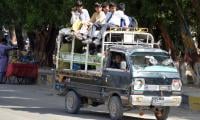TARBELA: At least 14 power generation units of Tarbela dam came to a grinding halt on ebbing water streams with electricity supply from its operational plants waning to 459 megawatts, officials told APP on Saturday.
The officials said power generation plants of Tarbela dam with installed capacity of 4,888 megawatts were closed owing to the receding water inflows in the lake, which also reduced the water level in the reservoir.
Tarbela dam’s officials said 14 power generation units of the dam have been shut down owing to the decreased water inflow. Only 459 megawatts of electricity have been produced with only three units of the dam working currently. The earth-filled dam is located on Indus River in Khyber Pakhtunkhwa.
The water storage capacity of the dam fell 53 feet and on Saturday with the water level of the dam recorded at 1,444 feet, according to the officials.
Shortage in the Tarbela lake reservoir badly affected both power generation and the agriculture sector.
Total 22,600 cusec feet of water inflow was recorded during the day, while outflow also remained at 40,000 cusecs, which were discharged in Ghazi Brotha stream.
Declining hydropower, which is a cheap source of energy, is expected to resume in upcoming summer when traditionally power deficit crosses 6,000-megawatt.
An American think tank Atlantic Council said 58 million people in Pakistan lack access to electricity, and the challenge is particularly acute in rural areas, where only 54 percent have access to electricity. “Pakistan’s progress in expanding access has been slower compared to some other countries,” the council said in a report last month.
Comparatively, Bangladesh boosted power access to 88 percent of its population in 2017 from 55 percent in 2010, and more recent estimates are as high as 95 percent.
“(The country’s) installed generation capacity has greatly expanded to 33,836 MW in February 2019 from 23,337 MW in 2014, and electricity generation increased by 11 percent from 2017 to 2018,” it added. “Pakistan continues to have a gap, however, of several thousand megawatts in the non-summer months when hydropower output is lower and electricity demand is high.”
The government is struggling to achieve universal electricity access by 2030, while priority towns in each province have already been identified.
The US think tank said Pakistan’s rural electrification programs are heavily focused on grid expansion by the various regional distribution companies, many of which are constrained in their ability to finance grid expansion, especially in the remote and sparsely populated areas of Balochistan and tribal areas. The council said expansion of electricity generation would meet rising demand and reduce the endemic power blackouts.
A representational image showing an oil refinery. — AFP/FileKARACHI: Pakistan Petroleum Limited has announced a...
P@SHA Chairman Zohaib Khan was the esteemed Chief Guest at Aptech 2023. — X/PASHAORG/FileKARACHI: Muhammad Zohaib...
PSX marked the listing of the Mahaana Islamic Index Exchange Traded Fund with a gong ceremony on April 23, 2024. —...
FPCCI Regional Chairman and VP Zaki Aijaz while speaking during a round table discussion on the challenges and...
This representational image shows Gold bars. — AFP/FileKARACHI: Gold prices in the local market fell by Rs7,800 per...
Security personnel walk past the US Federal Reserve building in Washington, DC on Oct 22, 2021. — AFPNew York:...







